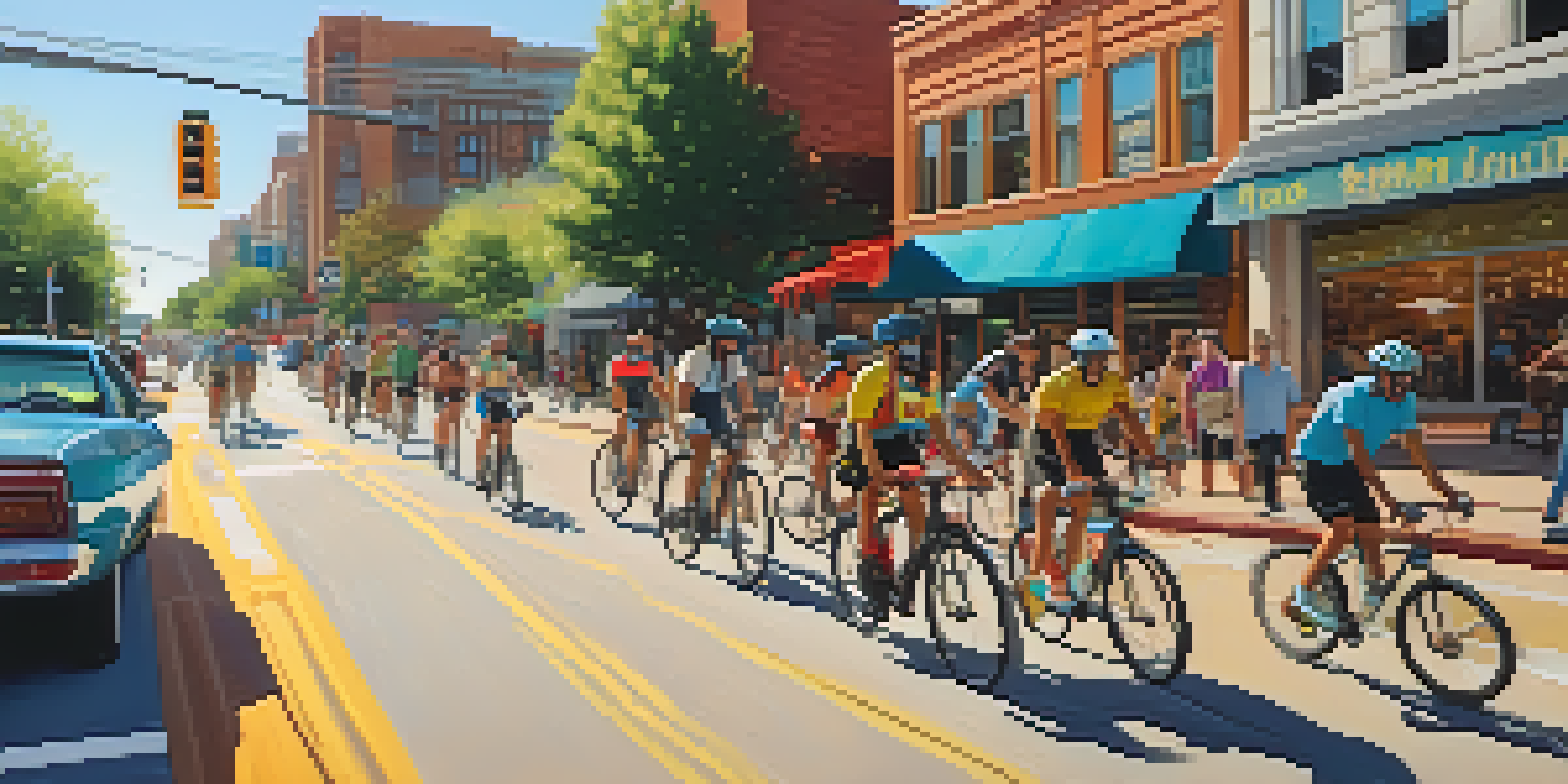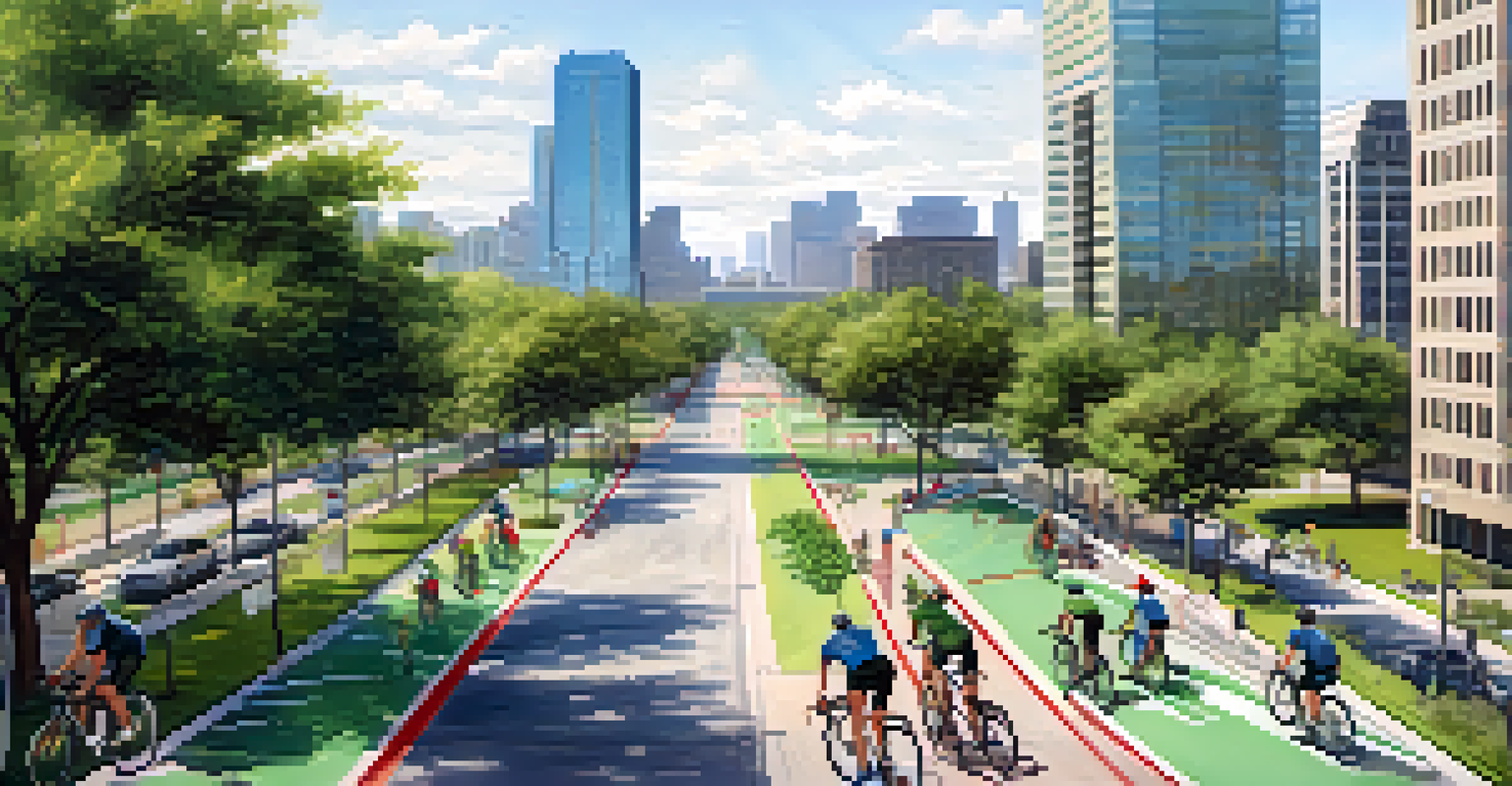The Impact of Cycling on Austin's Urban Environment

The Rise of Cycling in Austin: A Cultural Shift
Over the past decade, Austin has seen a remarkable rise in cycling as a preferred mode of transportation. This shift reflects a broader cultural change where residents are increasingly prioritizing sustainability and health. As bike lanes sprout across the city, cycling has become more than just a hobby; it's a lifestyle choice that resonates with the community's values.
Cycling is a simple and effective way to improve physical and mental health while reducing our carbon footprint.
Local events like the annual Austin B-cycle program promote cycling by making it more accessible to residents and visitors alike. The program not only encourages people to ride but also fosters a sense of community among cyclists. This collective enthusiasm for cycling has contributed to a vibrant urban culture, where cycling is celebrated as a fun and eco-friendly activity.
As more people take to the streets on two wheels, the perception of cycling has evolved. No longer viewed as just an alternative for the adventurous, it is now embraced by families, young professionals, and even commuters. This shift is crucial in understanding the overall impact cycling has on Austin's urban environment.
Cycling Infrastructure: Building a Better Austin
The development of cycling infrastructure is a pivotal factor in enhancing Austin's urban landscape. The city has invested in expanding bike lanes, improving safety measures, and creating dedicated paths for cyclists. These changes not only facilitate safer riding but also encourage more people to choose cycling over driving.

For instance, the recent addition of protected bike lanes has significantly reduced accidents involving cyclists. This not only reassures current riders but also attracts new ones who may have been hesitant to cycle due to safety concerns. The more robust infrastructure encourages a cycle-friendly culture, making Austin a more appealing place to live and commute.
Cycling: A Sustainable Lifestyle
Austin's rise in cycling reflects a cultural shift towards sustainability and healthier living.
Moreover, integrating cycling infrastructure into urban planning creates a more livable city for everyone. With less congestion and cleaner air, the benefits extend beyond cyclists to pedestrians and drivers alike. This interconnected approach to urban planning underscores the importance of cycling in shaping a healthier urban environment.
Environmental Benefits: Cycling and Sustainability
Cycling plays a significant role in promoting sustainability within Austin's urban environment. By opting for bikes over cars, residents can drastically reduce their carbon footprint. Each bike ride not only cuts down on greenhouse gas emissions but also contributes to a cleaner and more sustainable city.
Bicycles are a simple solution to some of the world's most complicated problems.
Furthermore, as cycling becomes more mainstream, it encourages a shift in public attitudes towards transportation. This can lead to a decrease in reliance on fossil fuels and an increase in investment in renewable energy sources. The collective impact of these lifestyle changes can help Austin move closer to its environmental goals.
In essence, cycling is a simple yet effective way for individuals to contribute to the city's sustainability efforts. The ripple effect of each pedal stroke is profound, as it fosters community awareness and commitment to eco-friendly practices. The more Austin embraces cycling, the more it paves the way for a greener future.
Health Impacts: Cycling for a Happier Community
The health benefits of cycling extend beyond just physical fitness; they also enhance mental well-being. Regular cycling can reduce stress, improve mood, and even promote social interactions among riders. As more residents adopt cycling as part of their daily routines, the overall health of the community improves.
Additionally, cycling can combat health issues related to sedentary lifestyles, such as obesity and heart disease. By integrating cycling into their lives, Austinites are not just getting exercise; they are also choosing a healthier, more active lifestyle. This shift has the potential to reduce healthcare costs for individuals and the community as a whole.
Investing in Cycling Infrastructure
Enhanced cycling infrastructure in Austin promotes safety, encourages more riders, and benefits the urban environment.
Moreover, community cycling events, such as group rides or charity races, foster a sense of belonging and camaraderie. These gatherings not only promote physical activity but also strengthen community ties, creating a happier, healthier Austin. The positive health impacts of cycling resonate throughout the city, making it a place where well-being is prioritized.
Economic Advantages: Boosting Local Businesses
Cycling not only benefits the environment and health but also provides economic advantages for Austin's local businesses. As more people cycle, there tends to be a noticeable increase in foot traffic to shops and cafes along popular bike routes. This boost in customers can be a game changer for small businesses trying to thrive in a competitive market.
Furthermore, the city's investment in cycling infrastructure often leads to higher property values in bike-friendly neighborhoods. Residents and potential buyers are increasingly drawn to areas with easy access to bike lanes and trails. This trend can result in a win-win situation, where both the community and local businesses flourish.
In essence, cycling can transform the economic landscape of Austin. By fostering a vibrant cycling culture, the city not only enhances its appeal but also supports local entrepreneurship. The economic ripple effects of cycling are evident, as it helps build a more resilient urban economy.
Community Engagement: Cycling as a Unifying Force
Cycling fosters a sense of community engagement and participation among Austin residents. Through various cycling events, such as charity rides and community bike maintenance workshops, individuals come together to share their passion for cycling. These gatherings promote inclusivity and create opportunities for people from diverse backgrounds to connect.
Moreover, local advocacy groups play a vital role in promoting cycling and amplifying community voices. By raising awareness about cycling issues, these organizations help ensure that residents' concerns are heard in discussions about urban planning and infrastructure. This engagement allows the cycling community to shape the city’s future.
Cycling Boosts Local Economies
As cycling increases, local businesses benefit from higher foot traffic and property values in bike-friendly neighborhoods.
As a unifying force, cycling encourages collaboration among residents, businesses, and local government. This synergy can lead to innovative solutions for urban challenges and create a more engaged citizenry. Ultimately, cycling serves as a bridge that brings people together, fostering a stronger, more connected Austin.
The Future of Cycling in Austin: Trends and Innovations
Looking ahead, the future of cycling in Austin appears promising, driven by emerging trends and innovative solutions. Electric bikes, or e-bikes, are gaining popularity, making cycling more accessible to a broader audience. This trend is particularly important in a hilly city like Austin, where e-bikes can help make longer commutes more manageable.
Additionally, advancements in technology are enhancing the cycling experience. From apps that provide real-time navigation to smart bike locks that enhance security, innovation is making cycling safer and more enjoyable. These developments could further encourage residents to adopt cycling as a primary mode of transportation.

Moreover, ongoing community engagement and advocacy will play a crucial role in shaping the future of cycling in Austin. As more residents advocate for better cycling infrastructure and policies, the city can continue to evolve into a more bike-friendly place. With a commitment to innovation and community, Austin is on the path to becoming a leading cycling city.